ECOSYSTEM for Class 12 BIOLOGY
INTRODUCTION
- An ecosystem can be visualised as a functional unit of nature, where living organisms interact among themselves and also with the surrounding physical environment. Ecosystem varies greatly in size from a small pond to a large forest or a sea. Many ecologists regard the entire biosphere as a global ecosystem, as a composite of all local ecosystems on Earth. Since this system is too big and complex to be studied at one time, it is convenient to divide it into two basic categories, namely the terrestrial and the aquatic. Forest, grassland and desert are some examples of terrestrial ecosystems; pond, lake, wetland, river and estuary are some examples of aquatic ecosystems. Crop fields and an aquarium may also be considered as man-made ecosystems.

INTRODUCTION
- An ecosystem can be visualised as a functional unit of nature, where living organisms interact among themselves and also with the surrounding physical environment. Ecosystem varies greatly in size from a small pond to a large forest or a sea. Many ecologists regard the entire biosphere as a global ecosystem, as a composite of all local ecosystems on Earth. Since this system is too big and complex to be studied at one time, it is convenient to divide it into two basic categories, namely the terrestrial and the aquatic. Forest, grassland and desert are some examples of terrestrial ecosystems; pond, lake, wetland, river and estuary are some examples of aquatic ecosystems. Crop fields and an aquarium may also be considered as man-made ecosystems.

Chapter Weightage
- The whole Unit X carries a total of 14 marks, and is split into four chapters including Ecosystem itself. The weightage of chapter 14 is 3.5 marks for the Class 12 final board. The questions are generally asked from topics like ecological succession, nutrient cycling or energy flow.
Chapter Weightage
- The whole Unit X carries a total of 14 marks, and is split into four chapters including Ecosystem itself. The weightage of chapter 14 is 3.5 marks for the Class 12 final board exams as well as neet . The questions are generally asked from topics like ecological succession, nutrient cycling or energy flow.
Ecosystem–Structure and Function
- Beta, iss ection me hum ecosystem ke structure and uske functions ke bare me padhenge.
- Ecosystem aisi community hai jo biotic and abiotic components ke interaction se banti hai.
- Now depending upon these components, ecosystem different types ke ho sakte hai jaise ki aquatic ecosystem, grassland ecosystem, marine ecosystem, pond ecosystem etc.
- Different species jo ek ecosystem me different levels ko occuo karti hai, ussi ka vertical distribution stratification kehlata hai jaise ki forest ecosystem me trees sabse top level pe honge, shrubs unse neeche and grasses bilkul bottom layer ko occupy karengi.
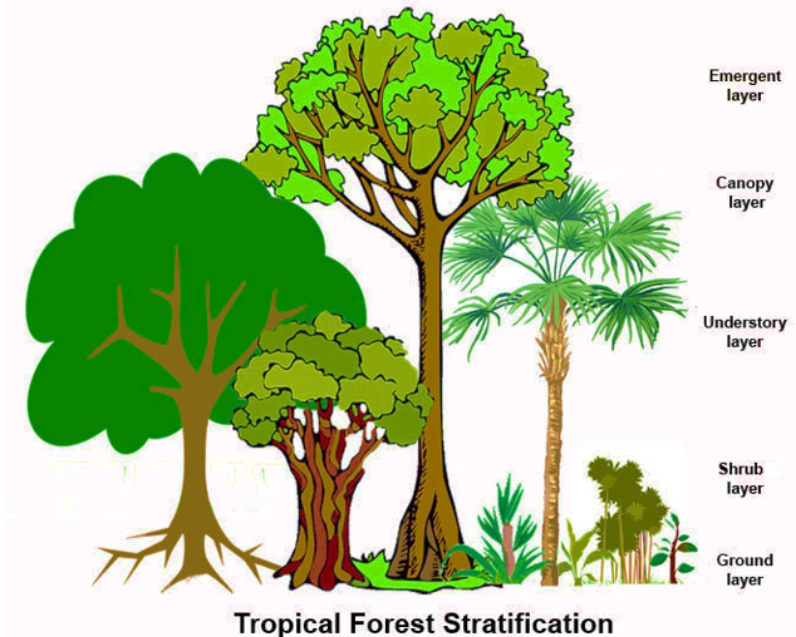
- Basic components ko ecosystem are :
- Productivity : Amount of biomass produced by an ecosystem
- Decomposition : breakdown of complex organic molecules into simple inorganic substances.
- Energy Flow : ek trophic level se dusri trophic level me energy ka flow.
- Nutrient Cycling : movement of nutrients and elements through various components of an ecosystem.
Ecosystem–Structure and Function
- Interaction of biotic and abiotic components result in a physical structure that is characteristic for each type of ecosystem.
- Vertical distribution of different species occupying different levels is called stratification. For example, trees occupy top vertical strata or layer of a forest, shrubs the second and herbs and grasses occupy the bottom layers.
- The main aspects of the ecosystem are :
- Productivity
- Decomposition
- Energy flow
- Nutrient cycling
- The term “Ecosystem” was first coined by A.G.Tansley, an English botanist, in 1935.
- Types of Ecosystem are :
- Terrestrial Ecosystem
- Forest Ecosystem
- Grassland Ecosystems
- Tundra Ecosystems
- Desert Ecosystem
- Aquatic Ecosystem
- Marine Ecosystem
- Freshwater Ecosystem
- Terrestrial Ecosystem
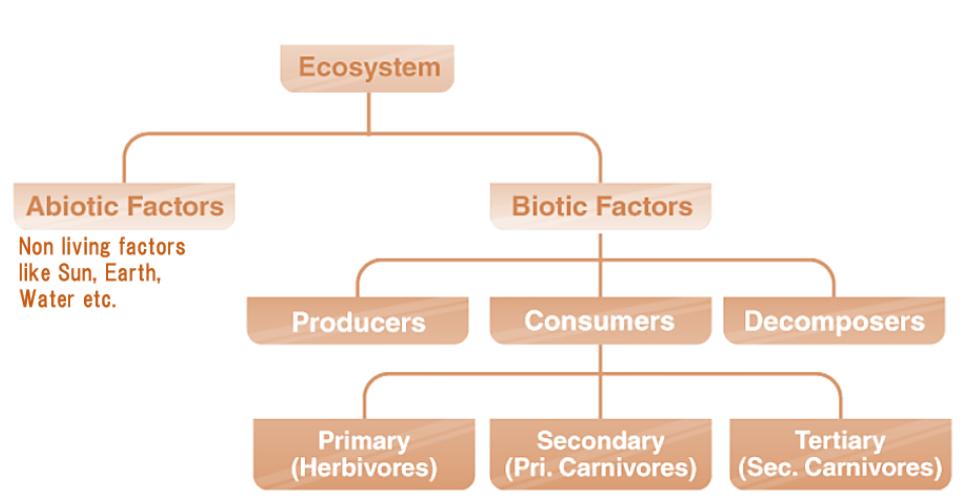
Ecosystem–Structure and Function
- Interaction of biotic and abiotic components result in a physical structure that is characteristic for each type of ecosystem.
- Vertical distribution of different species occupying different levels is called stratification. For example, trees occupy top vertical strata or layer of a forest, shrubs the second and herbs and grasses occupy the bottom layers.
- The main aspects of the ecosystem are :
- Productivity
- Decomposition
- Energy flow
- Nutrient cycling
- The term “Ecosystem” was first coined by A.G.Tansley, an English botanist, in 1935.
- Types of Ecosystem are :
- Terrestrial Ecosystem
- Forest Ecosystem
- Grassland Ecosystems
- Tundra Ecosystems
- Desert Ecosystem
- Aquatic Ecosystem
- Marine Ecosystem
- Freshwater Ecosystem
- Terrestrial Ecosystem

Productivity
- Primary production is defined as the amount of biomass or organic matter produced per unit area over a time period by plants during photosynthesis. It is expressed in terms of weight (g–2) or energy (kcal m–2).
- The rate of biomass production is called productivity. It is expressed in terms of g–2 yr–1 or (kcal m–2) yr–1 to compare the productivity of different ecosystems.
- It can be divided into gross primary productivity (GPP) and net primary productivity (NPP).
- Gross primary productivity of an ecosystem is the rate of production of organic matter during photosynthesis. A considerable amount of GPP is utilised by plants in respiration. Gross primary productivity minus respiration losses (R), is the net primary productivity (NPP).
GPP – R = NPP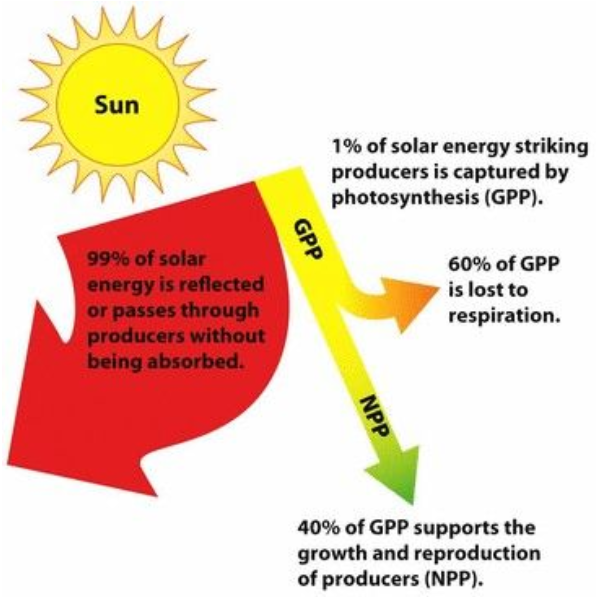
- Net primary productivity is the available biomass for the consumption to heterotrophs (herbivores and decomposers).
- Secondary productivity is defined as the rate of formation of new organic matter by consumers.
- The annual net primary productivity of the whole biosphere is approximately 170 billion tons (dry weight) of organic matter. Of this, despite occupying about 70 per cent of the surface, the productivity of the oceans is only 55 billion tons.
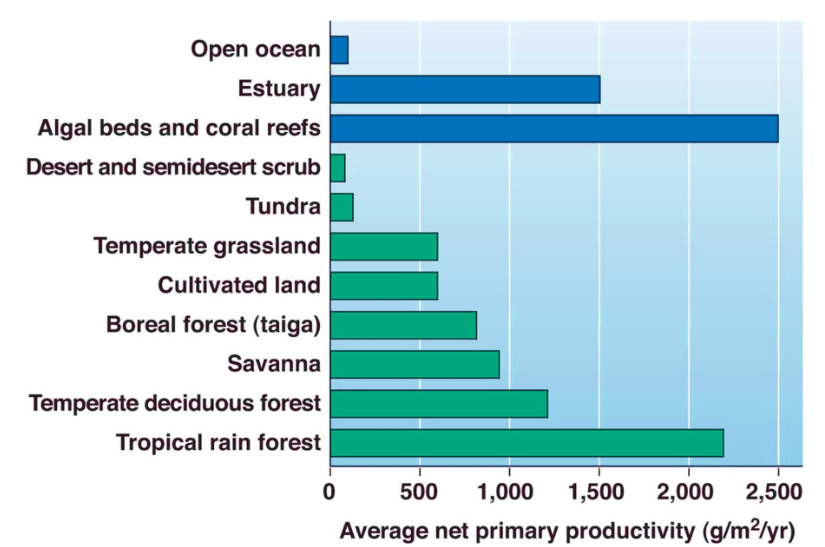
Productivity
- Koi bhi ecosystem, kisi given time period me per unit area jitna bhi biomass produce karta hai usko hum primary production kehte hai jo ki photosynthesis se accomplish kia jata hai.
- TOh biomass ke production ke rae ko hi hum productivity kehte hai jisko hum g-2yr-1 me ya Kcalm-2yr-1 me express karte hai.
- issi productivity ko hum Net primary productivity and Gross primary productivity me divide karte hai.
- Gross Primary productivity / GPP wo biomass hai jo plants ne photosynthesis ke waqt produce kia lekin plants keval output nhi dete na, kuch food wo bhi utilise karte hai hai khud ke liye jo respiration ki process se ATP/energy deta hai production ki toh inhi respiratory losses ( R) ko GPP me se minus karke jo bachi hui productivity hai wo net primary productivity kehlati hai.
- Secondary productivity organic matter ki formation ka wo rate hai jo consumers banate hai.
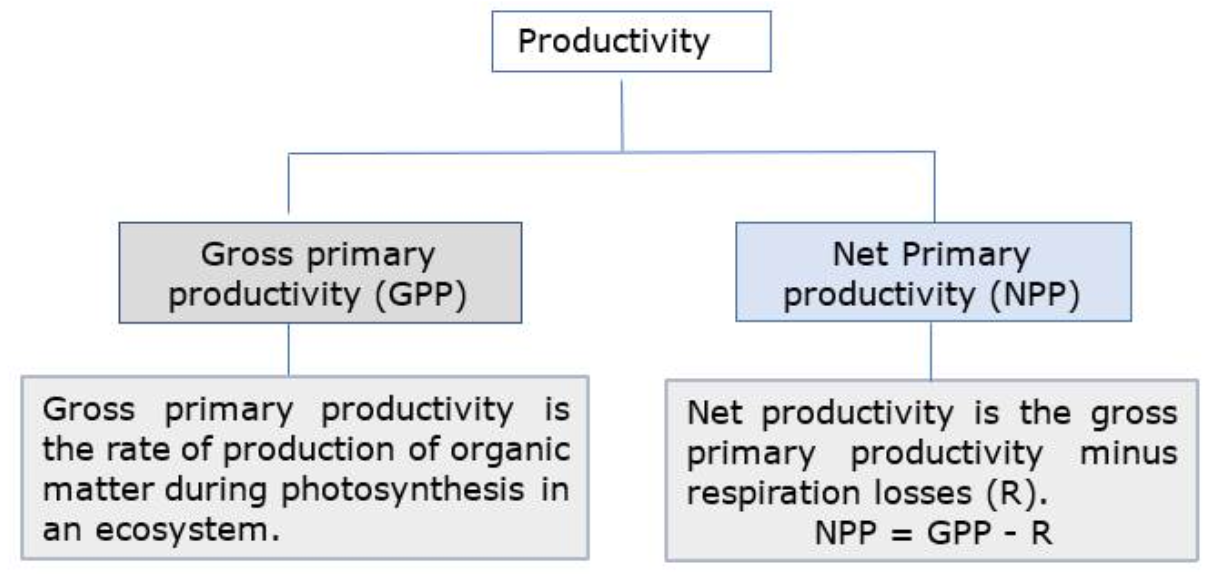
- Primary productivity iss cheez pe bhi depend karti hai ki producers kis habitat me hai and iske sath sath yeah baki environmental factors par bhi depend karta hai toh alag alag ecosystems me productivity ka rate alag alag hi hota hai.
- Purey biosphere ki annual primary productivity 170 billion tons (dry weight) hai jisme me oceans keval 55 billion tons ka contribution dete hai jabki oceans occupy nearly 70% of the earth’s surface, toh comparatively ocean ecosystem ki productivity low hai.
- Reasons for low productivity of ocean ecosystem :
- Presence of small floating autotrophic plants( less vascular than their terrestrial counterparts)
- Sunlight is not available beyond a certain depth.
- Minerals and nutrients can be a retarding factor based on location of the oceans.
- Photosynthetic capacity of the marine ecosystem is far less than that of advanced plants and trees on land.
Decomposition
- Breaking down of complex organic matter into inorganic substances like carbon dioxide, water and nutrients and the process is called decomposition.
- Dead plant remains such as leaves, bark, flowers and dead remains of animals, including fecal matter, constitute detritus, which is the raw material for decomposition.
- The important steps in the process of decomposition are
- Fragmentation
- Leaching
- Catabolism
- Humification
- Mineralisation
- Detritivores (e.g., earthworm) break down detritus into smaller particles. This process is called fragmentation.
- By the process of leaching, water soluble inorganic nutrients go down into the soil horizon and get precipitated as unavailable salts.
- Bacterial and fungal enzymes degrade detritus into simpler inorganic substances. This process is called as catabolism.
- Humification leads to accumulation of a dark coloured amorphous substance called humus that is highly resistant to microbial action and undergoes decomposition at an extremely slow rate. Being colloidal in nature it serves as a reservoir of nutrients.
- The humus is further degraded by some microbes and release of inorganic nutrients occur by the process known as mineralisation.
- Decomposition is largely an oxygen-requiring process. The rate of decomposition is controlled by chemical composition of detritus and climatic factors.
- In a particular climatic condition, decomposition rate is slower if detritus is rich in lignin and chitin, and quicker, if detritus is rich in nitrogen and water-soluble substances like sugars.
- Temperature and soil moisture are the most important climatic factors that regulate decomposition through their effects on the activities of soil microbes.
- Warm and moist environment favour decomposition whereas low temperature and anaerobiosis inhibit decomposition resulting in build up of organic materials.
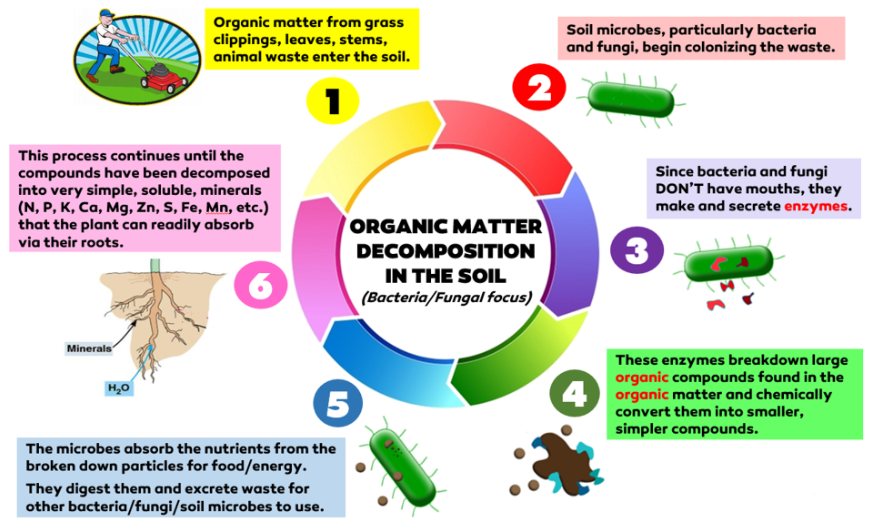
Productivity
- Primary production is defined as the amount of biomass or organic matter produced per unit area over a time period by plants during photosynthesis. It is expressed in terms of weight (g–2) or energy (kcal m–2).
- The rate of biomass production is called productivity. It is expressed in terms of g–2 yr–1 or (kcal m–2) yr–1 to compare the productivity of different ecosystems.
- It can be divided into gross primary productivity (GPP) and net primary productivity (NPP).
- Gross primary productivity of an ecosystem is the rate of production of organic matter during photosynthesis. A considerable amount of GPP is utilised by plants in respiration. Gross primary productivity minus respiration losses (R), is the net primary productivity (NPP).
GPP – R = NPP
- Net primary productivity is the available biomass for the consumption to heterotrophs (herbivores and decomposers).
- Secondary productivity is defined as the rate of formation of new organic matter by consumers.
- The annual net primary productivity of the whole biosphere is approximately 170 billion tons (dry weight) of organic matter. Of this, despite occupying about 70 per cent of the surface, the productivity of the oceans is only 55 billion tons.

Energy Flow
- Except for the deep sea hydro-thermal ecosystem, sun is the only source of energy for all ecosystems on Earth. Of the incident solar radiation less than 50 per cent of it is photosynthetically active radiation (PAR).
- Plants capture only 2-10 per cent of the PAR and this small amount of energy sustains the entire living world. unidirectional flow of energy from the sun to producers and then to consumers.
- Ecosystems are not exempt from the Second Law of thermodynamics. They need a constant supply of energy to synthesise the molecules they require, to counteract the universal tendency toward increasing disorderliness.
- The energy trapped by the producer, hence, is either passed on to a consumer or the organism dies. Death of organism is the beginning of the detritus food chain/web.
- The consumers that feed on these herbivores are carnivores, or more correctly primary carnivores (though secondary consumers). Those animals that depend on the primary carnivores for food are labelled secondary carnivores.
- The detritus food chain (DFC) begins with dead organic matter. It is made up of decomposers which are heterotrophic organisms, mainly fungi and bacteria. They meet their energy and nutrient requirements by degrading dead organic matter or detritus. These are also known as saprotrophs (sapro: to decompose). Decomposers secrete digestive enzymes that breakdown dead and waste materials into simple, inorganic materials, which are subsequently absorbed by them.
- Producers belong to the first trophic level, herbivores (primary consumer) to the second and carnivores (secondary consumer) to the third.
- Each trophic level has a certain mass of living material at a particular time called the standing crop. The standing crop is measured as the mass of living organisms (biomass) or the number in a unit area. The biomass of a species is expressed in terms of fresh or dry weight.
- The number of trophic levels in the grazing food chain is restricted as the transfer of energy follows 10 percent law – only 10 percent of the energy is transferred to each trophic level from the lower trophic level.
Decomposition
- Decomposition ka matlab hai complex organic substances ko simpler inorganic elements me todna. Yeah wo process hai jissey sare organic substances wapis nature me mil jate hai.
- Dead and decaying organic matter ko detritus bola jata hai and detritivores wo animals hai jo detritus ko fragmentation ki process ke dwara smaller particles me todte hai and then in smaller particles se water soluble nutrients pani me mil ke soil me ander tak jakr precipitate kar jate hai jisko hum leaching kehte hai.
- Catabolism wo chemical reactions hai jo kisi organism ya live cell ke ander hote hai and yeah reactions complex organic material ko enzymes ki help se breakdown karte hai.
- Humus ek dark coloured amorphous substance hai jiska accumulation hi humification kehlata hai. Microbe isko bhi degrade karte hai but ek bahut hi slow rate par. Humus ke degradation se minerals release hote hai and issi process ko mineralization bola jata hai.
- Decomposition ki process ko bhi mostly oxygen ki requirement hoti hai, and kis rate par yani ki kis speed se degradation o rha hai wo depend karta hai detritus ke chemical composition par.
- Jo substances kabhi degrade nhi hote ya fir itne slow rate se degrade ho ki wo virtually non degradable lage, unko hum non-biodegradable material kehte hai jaise ki PLastic.
- Temperature and soil ka moisture bhi degradation ke rate ko affect karta hai. Warm and moist temperature degradation ko favour karte hai.
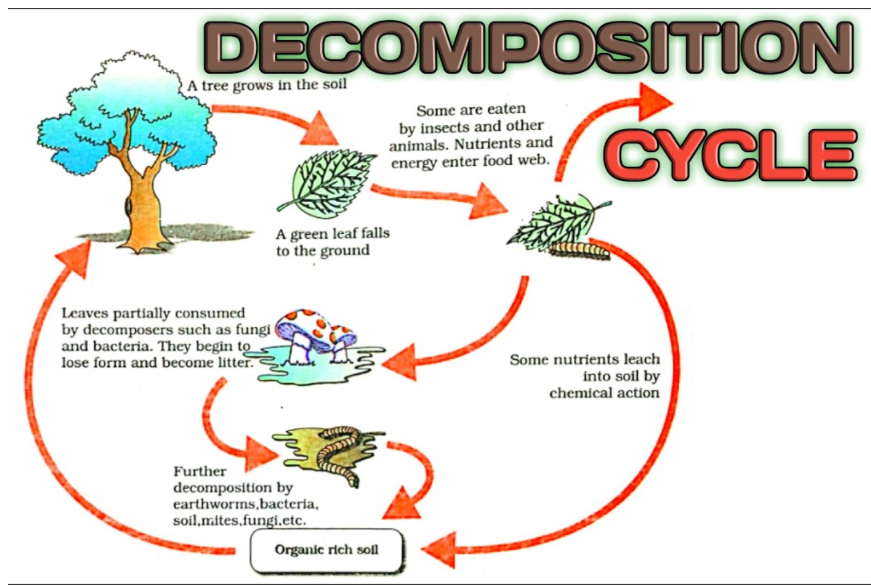
Ecological Pyramids
- The base of a pyramid is broad and it narrows down at the apex. One gets a similar shape, whether you express the food or energy relationship between organisms at different trophic level.
- Thus, relationships are expressed in terms of number, biomass or energy. The base of each pyramid represents the producers or the first trophic level while the apex represents tertiary or top level consumer. The three ecological pyramids that are usually studied are (a) pyramid of number; (b) pyramid of biomass and (c) pyramid of Energy.
- The trophic level represents a functional level, not a species as such. A given species may occupy more than one trophic level in the same ecosystem at the same time; for example, a sparrow is a primary consumer when it eats seeds, fruits, peas, and a secondary consumer when it eats insects and worms.
- Pyramid of energy is always upright, can never be inverted, because when energy flows from a particular trophic level to the next trophic level, some energy is always lost as heat at each step. Each bar in the energy pyramid indicates the amount of energy present at each trophic level in a given time or annually per unit area.
- There are certain limitations of ecological pyramids such as it does not take into account the same species belonging to two or more trophic levels. It assumes a simple food chain, something that almost never exists in nature; it does not accommodate a food web. Moreover, saprophytes are not given any place in ecological pyramids even though they play a vital role in the ecosystem.
Decomposition
- Breaking down of complex organic matter into inorganic substances like carbon dioxide, water and nutrients and the process is called decomposition.
- Dead plant remains such as leaves, bark, flowers and dead remains of animals, including fecal matter, constitute detritus, which is the raw material for decomposition.
- The important steps in the process of decomposition are
- Fragmentation
- Leaching
- Catabolism
- Humification
- Mineralisation
- Detritivores (e.g., earthworm) break down detritus into smaller particles. This process is called fragmentation.
- By the process of leaching, water soluble inorganic nutrients go down into the soil horizon and get precipitated as unavailable salts.
- Bacterial and fungal enzymes degrade detritus into simpler inorganic substances. This process is called as catabolism.
- Humification leads to accumulation of a dark coloured amorphous substance called humus that is highly resistant to microbial action and undergoes decomposition at an extremely slow rate. Being colloidal in nature it serves as a reservoir of nutrients.
- The humus is further degraded by some microbes and release of inorganic nutrients occur by the process known as mineralisation.
- Decomposition is largely an oxygen-requiring process. The rate of decomposition is controlled by chemical composition of detritus and climatic factors.
- In a particular climatic condition, decomposition rate is slower if detritus is rich in lignin and chitin, and quicker, if detritus is rich in nitrogen and water-soluble substances like sugars.
- Temperature and soil moisture are the most important climatic factors that regulate decomposition through their effects on the activities of soil microbes.
- Warm and moist environment favour decomposition whereas low temperature and anaerobiosis inhibit decomposition resulting in build up of organic materials.

Ecological Succession
- An important characteristic of all communities is that their composition and structure constantly change in response to the changing environmental conditions. This change is orderly and sequential, parallel with the changes in the physical environment.
- These changes lead finally to a community that is in near equilibrium with the environment and that is called a climax community.
- The gradual and fairly predictable change in the species composition of a given area is called ecological succession.
- During succession some species colonise an area and their populations become more numerous, whereas populations of other species decline and even disappear.
- The entire sequence of communities that successively change in a given area are called sere(s). The individual transitional communities are termed seral stages or seral communities.
- In the successive seral stages there is an increase in the number of species and organisms as well as an increase in the total biomass.
- Before a biotic community of diverse organisms can become established, there must be soil. Depending mostly on the climate, it takes natural processes several hundred to several thousand years to produce fertile soil on bare rock.
- Secondary succession begins in areas where natural biotic communities have been destroyed such as in abandoned farm lands, burned or cut forests, lands that have been flooded. Since some soil or sediment is present, succession is faster than primary succession.
- At any time during primary or secondary succession, natural or human induced disturbances (fire, deforestation, etc.), can convert a particular seral stage of succession to an earlier stage.
- Hydrarch succession takes place in wetter areas and the successional series progress from hydric to the mesic conditions. As against this, xerarch succession takes place in dry areas and the series progress from xeric to mesic conditions. Hence, both hydrarch and xerarch successions lead to medium water conditions (mesic) – neither too dry (xeric) nor too wet (hydric).
- The species that invade a bare area are called pioneer species.
- Xerach Succession : In primary succession on rocks these are usually lichens which are able to secrete acids to dissolve rock, helping in weathering and soil formation. These later pave way to some very small plants like bryophytes, which are able to take hold in the small amount of soil. They are, with time, succeeded by bigger plants, and after several more stages, ultimately a stable climax forest community is formed. The climax community remains stable as long as the environment remains unchanged. With time the xerophytic habitat gets converted into a mesophytic one.
- Hydrarch Succession : In primary succession in water, the pioneers are the small phytoplanktons, they are replaced with time by rooted-submerged plants, rooted-floating angiosperms followed by free-floating plants, then reed swamp, marsh-meadow, scrub and finally the trees. The climax again would be a forest. With time the water body is converted into land. In secondary succession the species that invade depend on the condition of the soil, availability of water, the environment as also the seeds or other propagules present. Since soil is already there, the rate of succession is much faster and hence, climax is also reached more quickly.
Energy Flow
- Kisi bhi ecosystem me bahut sari trophic levels hoti hai jisme higher trophic wale organism generally low trophic level wale organisms pe feed karte hai jaise ki grass (producer) pe herbivores feed karte hai and herbivores pe carnivores and omnivores bhi feed karenge toh inhi energy levels me food ke through energy jati hai toh issi ek trophic level se higher trophic level ke unidirectional flow of energy ko hum energy flow bolte hai.
- Sun sabhi ecosystems ka primary source hai energy ke liye, except for deep sea hydro thermal ecosystem. Lekin sun ki 100% energy plants food bnane ke liye utilise nhi kar sakte.
- Jitna sunlight aati hai usme se aadhi se kam light hi photosynthetically active radiation se belong karti hai jisko plants actual me photosynthesis ke liye use kar sakte hai lekin plants PAR ka keval 2-10% hi capture kar pate hai toh yhi 2-10% energy wo actual energy hai jo puri earth me sabhi ecosystems ko sustain karne ke liye energy deri hai.
- Food chains and food web ka concept sabhi jante hai. Ek common sa example hai Grass→Goat→Man.
- Detritus food chain aisi chain hai jo dead and decaying substances se shuru hoti hai, jinpe decomposers feed karte hai.
- Different food chains ke beech me interaction se food web banta hai.
- Different trophic levels in an ecosystem :
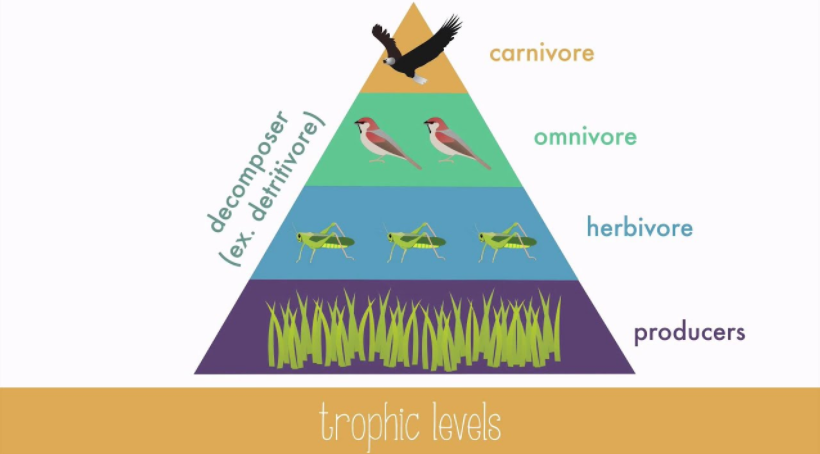
- Kisi bhi ecosystem ya biome me kisi bhi time par par jitna bhi living material present hota hai usko standing crop bola jata hai. Isko agar weight me measure karte hai toh isko standing biomass bolte hai.
- 10% Law yeah kehta hai ki jab bhi energy ek trophic level se dusri trophic level tak jati hai toh 90% energy toh lost ho jati hai and keval 10% energy hi next trophic level tak ja pati hai and yhi 10% law karan hai ki food chains me generally 3-4 trophic levels se jyada trophic levels nahi hote.
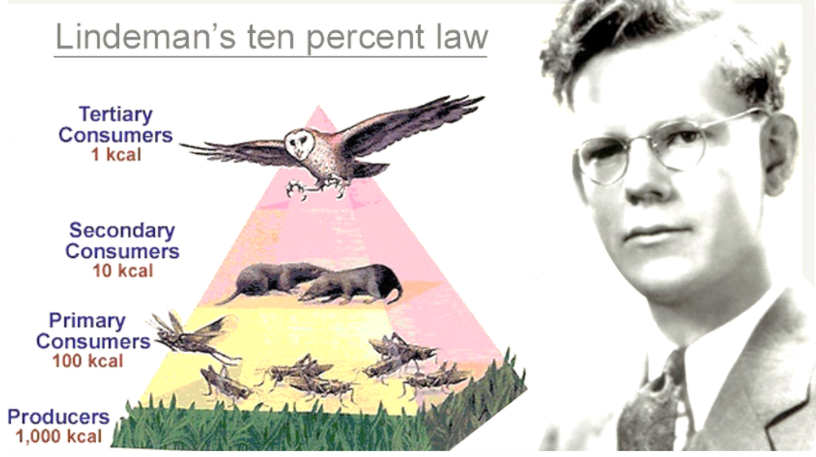
Nutrient Cycling
- The amount of nutrients, such as carbon, nitrogen, phosphorus, calcium, etc., present in the soil at any given time, is referred to as the standing state.
- The movement of nutrient elements through the various components of an ecosystem is called nutrient cycling. Another name of nutrient cycling is biogeochemical cycles (bio: living organism, geo: rocks, air, water).
- Nutrient cycles are of two types: (a) gaseous - Nitrogen and Carbon Cycle and (b) sedimentary - Sulphur and Phosphorus Cycle.
- Carbon Cycle : 71 percent carbon is found dissolved in oceans. Carbon constitutes49 per cent of dry weight of organisms and is next only to water. According to one estimate 4 × 1013 kg of carbon is fixed in the biosphere through photosynthesis annually.

- Phosphorus Cycle : Phosphorus is a major constituent of biological membranes, nucleic acids and cellular energy transfer systems. Many animals also need large quantities of this element to make shells, bones and teeth. The natural reservoir of phosphorus is rock, which contains phosphorus in the form of phosphates.
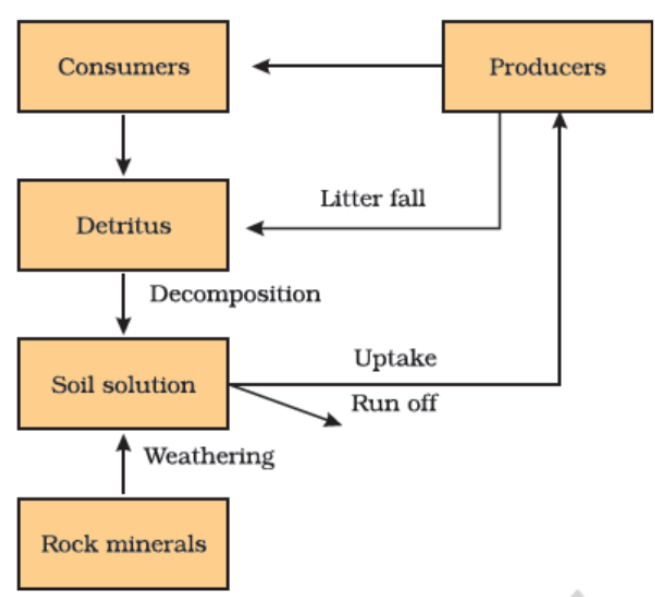
- Nitrogen cycle :
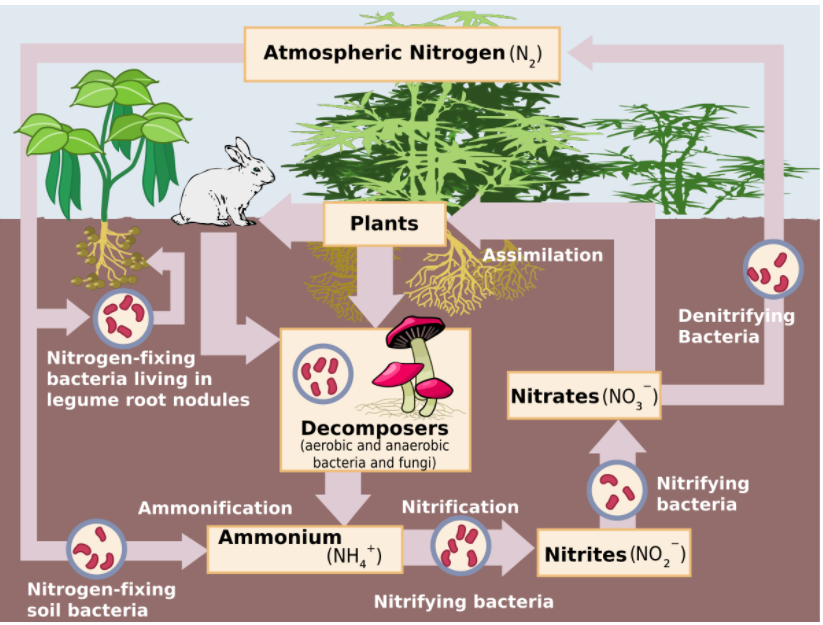
- Sulphur Cycle :
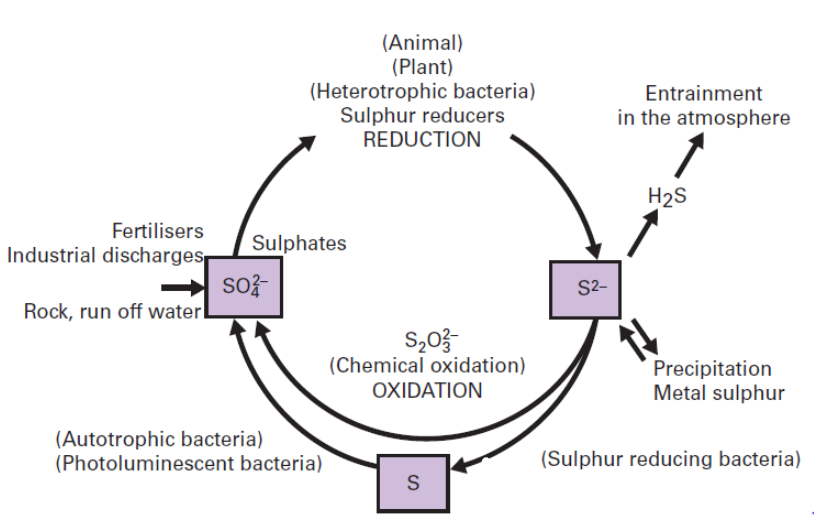
Energy Flow
- Except for the deep sea hydro-thermal ecosystem, sun is the only source of energy for all ecosystems on Earth. Of the incident solar radiation less than 50 per cent of it is photosynthetically active radiation (PAR).
- Plants capture only 2-10 per cent of the PAR and this small amount of energy sustains the entire living world. unidirectional flow of energy from the sun to producers and then to consumers.
- Ecosystems are not exempt from the Second Law of thermodynamics. They need a constant supply of energy to synthesise the molecules they require, to counteract the universal tendency toward increasing disorderliness.
- The energy trapped by the producer, hence, is either passed on to a consumer or the organism dies. Death of organism is the beginning of the detritus food chain/web.
- The consumers that feed on these herbivores are carnivores, or more correctly primary carnivores (though secondary consumers). Those animals that depend on the primary carnivores for food are labelled secondary carnivores.
- The detritus food chain (DFC) begins with dead organic matter. It is made up of decomposers which are heterotrophic organisms, mainly fungi and bacteria. They meet their energy and nutrient requirements by degrading dead organic matter or detritus. These are also known as saprotrophs (sapro: to decompose). Decomposers secrete digestive enzymes that breakdown dead and waste materials into simple, inorganic materials, which are subsequently absorbed by them.
- Producers belong to the first trophic level, herbivores (primary consumer) to the second and carnivores (secondary consumer) to the third.
- Each trophic level has a certain mass of living material at a particular time called the standing crop. The standing crop is measured as the mass of living organisms (biomass) or the number in a unit area. The biomass of a species is expressed in terms of fresh or dry weight.
- The number of trophic levels in the grazing food chain is restricted as the transfer of energy follows 10 percent law – only 10 percent of the energy is transferred to each trophic level from the lower trophic level.
Ecosystem Services
- Definition : Ecosystem services are the benefits provided to humans through the transformations of resources (or environmental assets, including land, water, vegetation and atmosphere) into a flow of essential goods and services e.g. clean air, water, and food (Constanza et al. 1997).
- The products of ecosystem processes are named as ecosystem services, for example, healthy forest ecosystems purify air and water, mitigate droughts and floods, cycle nutrients, generate fertile soils, provide wildlife habitat, maintain biodiversity, pollinate crops, provide storage site for carbon and also provide aesthetic, cultural and spiritual values.
- An ecosystem is a dynamic community comprising populations of plants, animals, microorganisms and the non-living environment interacting together as a functional unit. Environmental factors, such as soil type, position in the landscape, climate and water availability, determine the presence and distribution of ecosystems. The main inputs to ecosystems are sunlight, soil, nutrients and water, while wastes from one part of the system form fuel for other parts. A key output is biomass (or carbon-based life) regenerating itself.
- An ecosystem functions by continually cycling energy and materials through living organisms that grow, reproduce and then die. This cycling of energy and materials through living organisms has evolved in response to a mix of disturbances (eg. fires or floods), stresses (eg. droughts or diseases) and ecological interactions (eg. competition or predation) over millions of years. Recent changes in the frequency and intensity of these disturbances and stresses raises important issues about the ability of species and ecosystems to survive and adapt.
- When ecosystems are modified to meet society’s needs, they often require additional inputs, such as fertilisers, pesticides or fuel, which can be both beneficial and harmful. The benefits include the production of commodities while the run-off of nutrients or pesticides into streams can result in impaired water quality. Towns and cities can also be viewed as modified, human-dominated ecosystems that require flows of resource inputs from which energy, water and materials are extracted and used to support human wellbeing and culture, while producing concentrated waste streams that are detoxified and absorbed by nature. Efforts to increase the reuse and recycling of waste materials can be seen as shifting ecosystems into a more cyclic form, closer to the pattern of natural ecosystems.
Ecological Pyramids
- Different trophic levels pe jo organisms hai unme and energy flow me relationship dikhane ke liye we use pyramids.
- Pyramid of Numbers : Bahut sare primary producers food synthesize karte hai. Toh inpe feed karne ale primary consumers ka number kam hoga and then issi way me secondary and tertiary consumers ka bhi number or bhi kam hoga toh base wide hoga and apex patli hogi like a typical pyramid.
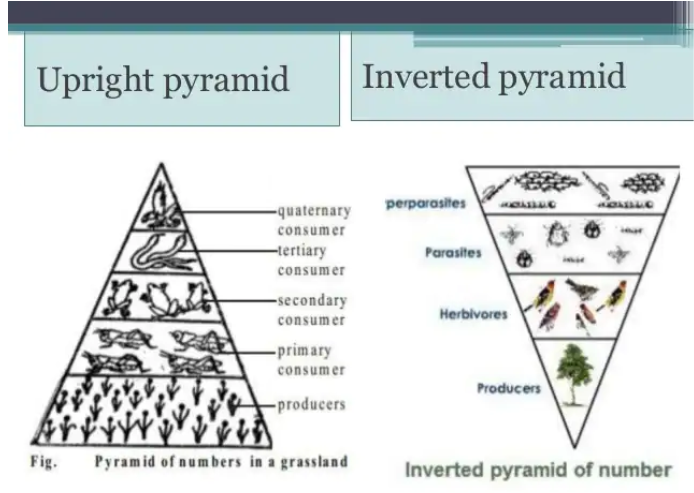
- Pyramid of biomass generally upright hota hai but aquatic ecosystem me upside down yani ki inverted pyramid hota hai kyunki uss case me small standing crop of phytoplankton supports large standing crop of zooplankton.

- Pyramid of energy hamesha upright hi hoga.
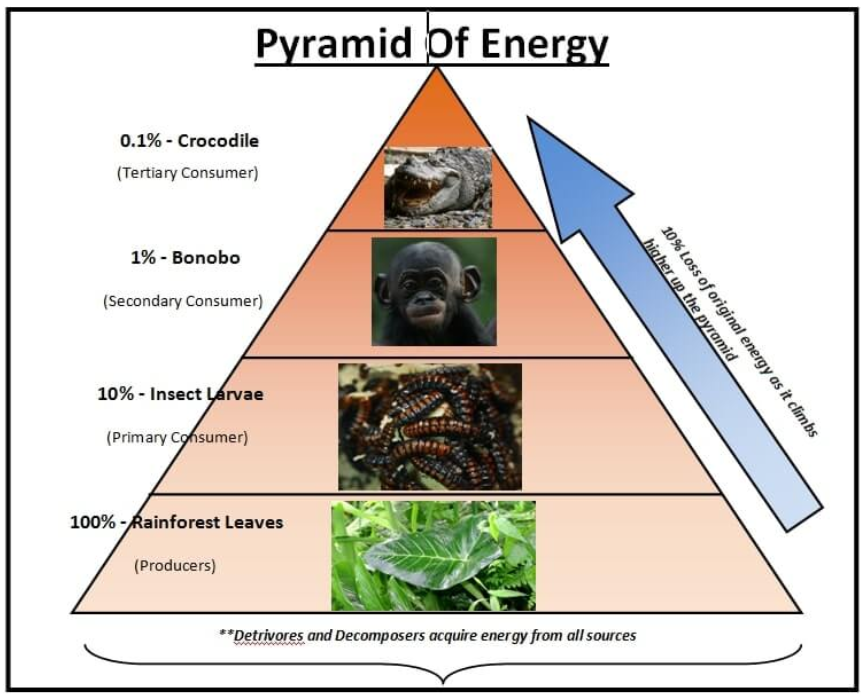
Summary
- An ecosystem is a functional unit of nature and comprises abiotic and biotic components. Abiotic components are inorganic materials- air, water and soil, whereas biotic components are producers, consumers and decomposers. Each ecosystem has characteristic physical structure resulting from interaction amongst abiotic and biotic components. Species composition and stratification are the two main structural features of an ecosystem. Based on source of nutrition every organism occupies a place in an ecosystem.
- Productivity, decomposition, energy flow, and nutrient cycling are the four important components of an ecosystem. Primary productivity is the rate of capture of solar energy or biomass production of the producers. It is divided into two types: gross primary productivity (GPP) and net primary productivity (NPP). Rate of capture of solar energy or total production of organic matter is called as GPP. NPP is the remaining biomass or the energy left after utilisation of producers. Secondary productivity is the rate of assimilation of food energy by the consumers. In decomposition, complex organic compounds of detritus are converted to carbon dioxide, water and inorganic nutrients by the decomposers. Decomposition involves three processes, namely fragmentation of detritus, leaching and catabolism.
- Energy flow is unidirectional. First, plants capture solar energy and then, food is transferred from the producers to decomposers. Organisms of different trophic levels in nature are connected to each other for food or energy relationship forming a food chain. The storage and movement of nutrient elements through the various components of the ecosystem is called nutrient cycling; nutrients are repeatedly used through this process. Nutrient cycling is of two types—gaseous and sedimentary. Atmosphere or hydrosphere is the reservoir for the gaseous type of cycle (carbon), whereas Earth’s crust is the reservoir for sedimentary type (phosphorus). Products of ecosystem processes are named as ecosystem services, e.g., purification of air and water by Forests.
- The biotic community is dynamic and undergoes changes with the passage of time. These changes are sequentially ordered and constitute ecological succession. Succession begins with invasion of a bare lifeless area by pioneers which later pave way for successors and ultimately a stable climax community is formed. The climax community remains stable as long as the environment remains unchanged.
Ecological Pyramids
- The base of a pyramid is broad and it narrows down at the apex. One gets a similar shape, whether you express the food or energy relationship between organisms at different trophic level.
- Thus, relationships are expressed in terms of number, biomass or energy. The base of each pyramid represents the producers or the first trophic level while the apex represents tertiary or top level consumer. The three ecological pyramids that are usually studied are (a) pyramid of number; (b) pyramid of biomass and (c) pyramid of Energy.
- The trophic level represents a functional level, not a species as such. A given species may occupy more than one trophic level in the same ecosystem at the same time; for example, a sparrow is a primary consumer when it eats seeds, fruits, peas, and a secondary consumer when it eats insects and worms.
- Pyramid of energy is always upright, can never be inverted, because when energy flows from a particular trophic level to the next trophic level, some energy is always lost as heat at each step. Each bar in the energy pyramid indicates the amount of energy present at each trophic level in a given time or annually per unit area.
- There are certain limitations of ecological pyramids such as it does not take into account the same species belonging to two or more trophic levels. It assumes a simple food chain, something that almost never exists in nature; it does not accommodate a food web. Moreover, saprophytes are not given any place in ecological pyramids even though they play a vital role in the ecosystem.
Ecological Succession
- Kisi bhi jagah pe different biotic communities ka successive development jo ultimately ek climax community (jo ki apne environment ke sath nearly equilibrium me hota hai) bna leta hai, vahi ecological succession kehlata hai.
- Sabhi communities changing environment ke sath change hoti rehti hai lekin yeh change bahut hi slow and gradual hota hai.
- Communities ki sequence jo ek ke baad ek successive change lekr aati hai unhi ko hum sere(s) kehte hai.
- Agar kisi place pe sabse pehle yani ki first time succession ho rha ho toh usko hum primary succession kehte hai lekin agar koi aisa lace ho jhan pehle life thi jaise ki for example, ek forest hai and wo forest fire me destroy hogya toh uske kuch saal baad hi vhaan pe firse new life emerge ho jati hai and yeah bhi ecological succession hi hai lekin ek fast rate par toh isko hum secondary succession kehte hai.
- Succession on a bare rock / Lithosere-Xerosere Steps :
- Lichen stage : bare rock pe sabse pehle lichen grow karna shuru karti hai toh inko hum pioneer species kehte hai. Lichen cracks vgarah cause karta hai rock me jinme ultimately mosses (bryophytes) grow karna shuru karenge.
- Moss stage : lichen humus rich cracks bnate hai jinko mosses invade karte hai.
- Annual Grass Stage : moss stage or bhi humus create arti hai jisme grasses invade karti hai and grasses ki roots se further fragmentation and humus rich soil production shuru ho jata hai.
- Perennial Grass Stage slowly slowly annual grass stage ko replace kar deti hai. Perennial graases me runners and rhizomes hote hai jo further soil development me help karte hai.
- Shrub stage : ultimately chote chote plants grow karna shuru kar dete hai.
- Climax Community : finally, trees, herbs, shrubs and grasses milkar ek forest bna deti hai jo ki lithosere succession ki climax community hai.
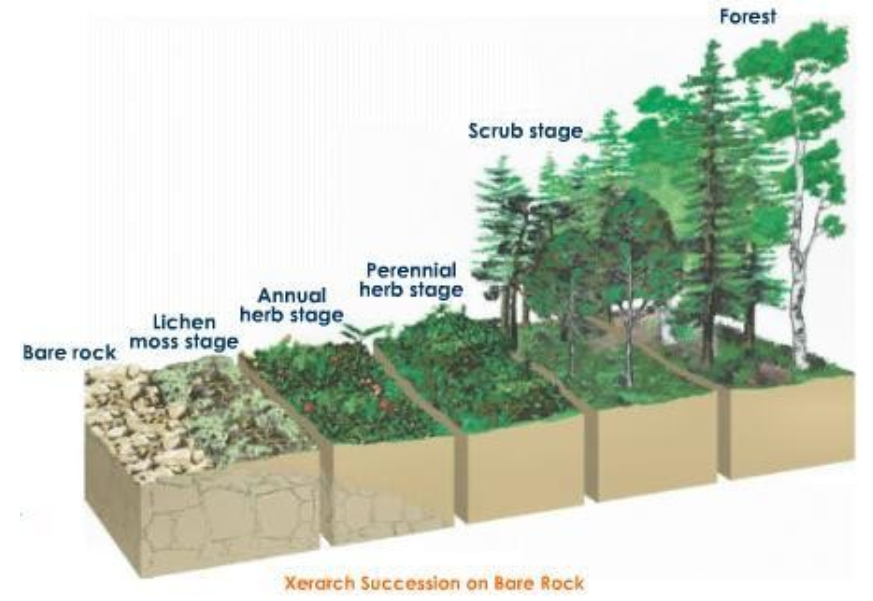
- Hydrosere :
- Plankton Stage : hydrosere me phytoplanktons like diatoms and blue green algae are pioneer species.
- Inke peeche peeche hi zooplankton aa jate hai.
- Submerged stage : jaisa ki naam bta rha hai, submerged chote chote aquatic plants jaise ki hydrilla vgarah aate hai iss stage me.
- Next stage aati hai Floating stage jo ki shallow paani me ubharte hai jaise ki Azolla vgarah.
- Reed Swamp stage : ab amphibian plants ya helophytes vgarah grow karna shuru kar dete hai jo ki or bhi jyada humus vgarah produce karte hai.
- Sedge/Marsh Meadow Stage : or bhi jyada plants vgarah grow kar jate hai and free water lagbhag disappear hi ho jata hai.
- Scrub stage/ Woodland Stage : or bhi jyada plants grow kar jate hai including some tall trees and day light plants.
- Eventually forest ki formation hojati hai toh again same climax community.
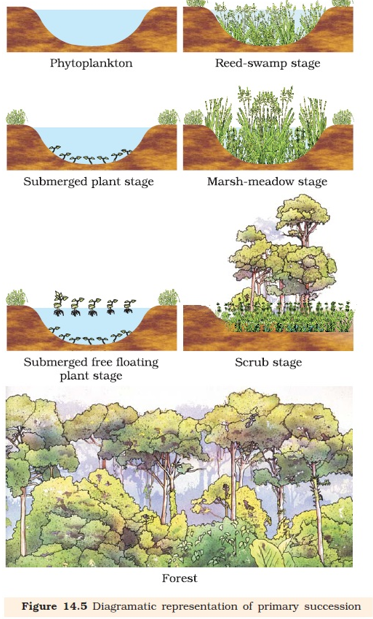
Ecological Succession
- An important characteristic of all communities is that their composition and structure constantly change in response to the changing environmental conditions. This change is orderly and sequential, parallel with the changes in the physical environment.
- These changes lead finally to a community that is in near equilibrium with the environment and that is called a climax community.
- The gradual and fairly predictable change in the species composition of a given area is called ecological succession.
- During succession some species colonise an area and their populations become more numerous, whereas populations of other species decline and even disappear.
- The entire sequence of communities that successively change in a given area are called sere(s). The individual transitional communities are termed seral stages or seral communities.
- In the successive seral stages there is an increase in the number of species and organisms as well as an increase in the total biomass.
- Before a biotic community of diverse organisms can become established, there must be soil. Depending mostly on the climate, it takes natural processes several hundred to several thousand years to produce fertile soil on bare rock.
- Secondary succession begins in areas where natural biotic communities have been destroyed such as in abandoned farm lands, burned or cut forests, lands that have been flooded. Since some soil or sediment is present, succession is faster than primary succession.
- At any time during primary or secondary succession, natural or human induced disturbances (fire, deforestation, etc.), can convert a particular seral stage of succession to an earlier stage.
- Hydrarch succession takes place in wetter areas and the successional series progress from hydric to the mesic conditions. As against this, xerarch succession takes place in dry areas and the series progress from xeric to mesic conditions. Hence, both hydrarch and xerarch successions lead to medium water conditions (mesic) – neither too dry (xeric) nor too wet (hydric).
- The species that invade a bare area are called pioneer species.
- Xerach Succession : In primary succession on rocks these are usually lichens which are able to secrete acids to dissolve rock, helping in weathering and soil formation. These later pave way to some very small plants like bryophytes, which are able to take hold in the small amount of soil. They are, with time, succeeded by bigger plants, and after several more stages, ultimately a stable climax forest community is formed. The climax community remains stable as long as the environment remains unchanged. With time the xerophytic habitat gets converted into a mesophytic one.
- Hydrarch Succession : In primary succession in water, the pioneers are the small phytoplanktons, they are replaced with time by rooted-submerged plants, rooted-floating angiosperms followed by free-floating plants, then reed swamp, marsh-meadow, scrub and finally the trees. The climax again would be a forest. With time the water body is converted into land. In secondary succession the species that invade depend on the condition of the soil, availability of water, the environment as also the seeds or other propagules present. Since soil is already there, the rate of succession is much faster and hence, climax is also reached more quickly.
Nutrient Cycling
- The amount of nutrients, such as carbon, nitrogen, phosphorus, calcium, etc., present in the soil at any given time, is referred to as the standing state.
- The movement of nutrient elements through the various components of an ecosystem is called nutrient cycling. Another name of nutrient cycling is biogeochemical cycles (bio: living organism, geo: rocks, air, water).
- Nutrient cycles are of two types: (a) gaseous - Nitrogen and Carbon Cycle and (b) sedimentary - Sulphur and Phosphorus Cycle.
- Carbon Cycle : 71 percent carbon is found dissolved in oceans. Carbon constitutes49 per cent of dry weight of organisms and is next only to water. According to one estimate 4 × 1013 kg of carbon is fixed in the biosphere through photosynthesis annually.

- Phosphorus Cycle : Phosphorus is a major constituent of biological membranes, nucleic acids and cellular energy transfer systems. Many animals also need large quantities of this element to make shells, bones and teeth. The natural reservoir of phosphorus is rock, which contains phosphorus in the form of phosphates.

- Nitrogen cycle :

- Sulphur Cycle :

Ecosystem Services
- Definition : Ecosystem services are the benefits provided to humans through the transformations of resources (or environmental assets, including land, water, vegetation and atmosphere) into a flow of essential goods and services e.g. clean air, water, and food (Constanza et al. 1997).
- The products of ecosystem processes are named as ecosystem services, for example, healthy forest ecosystems purify air and water, mitigate droughts and floods, cycle nutrients, generate fertile soils, provide wildlife habitat, maintain biodiversity, pollinate crops, provide storage site for carbon and also provide aesthetic, cultural and spiritual values.
- An ecosystem is a dynamic community comprising populations of plants, animals, microorganisms and the non-living environment interacting together as a functional unit. Environmental factors, such as soil type, position in the landscape, climate and water availability, determine the presence and distribution of ecosystems. The main inputs to ecosystems are sunlight, soil, nutrients and water, while wastes from one part of the system form fuel for other parts. A key output is biomass (or carbon-based life) regenerating itself.
- An ecosystem functions by continually cycling energy and materials through living organisms that grow, reproduce and then die. This cycling of energy and materials through living organisms has evolved in response to a mix of disturbances (eg. fires or floods), stresses (eg. droughts or diseases) and ecological interactions (eg. competition or predation) over millions of years. Recent changes in the frequency and intensity of these disturbances and stresses raises important issues about the ability of species and ecosystems to survive and adapt.
- When ecosystems are modified to meet society’s needs, they often require additional inputs, such as fertilisers, pesticides or fuel, which can be both beneficial and harmful. The benefits include the production of commodities while the run-off of nutrients or pesticides into streams can result in impaired water quality. Towns and cities can also be viewed as modified, human-dominated ecosystems that require flows of resource inputs from which energy, water and materials are extracted and used to support human wellbeing and culture, while producing concentrated waste streams that are detoxified and absorbed by nature. Efforts to increase the reuse and recycling of waste materials can be seen as shifting ecosystems into a more cyclic form, closer to the pattern of natural ecosystems.
Summary
- An ecosystem is a functional unit of nature and comprises abiotic and biotic components. Abiotic components are inorganic materials- air, water and soil, whereas biotic components are producers, consumers and decomposers. Each ecosystem has characteristic physical structure resulting from interaction amongst abiotic and biotic components. Species composition and stratification are the two main structural features of an ecosystem. Based on source of nutrition every organism occupies a place in an ecosystem.
- Productivity, decomposition, energy flow, and nutrient cycling are the four important components of an ecosystem. Primary productivity is the rate of capture of solar energy or biomass production of the producers. It is divided into two types: gross primary productivity (GPP) and net primary productivity (NPP). Rate of capture of solar energy or total production of organic matter is called as GPP. NPP is the remaining biomass or the energy left after utilisation of producers. Secondary productivity is the rate of assimilation of food energy by the consumers. In decomposition, complex organic compounds of detritus are converted to carbon dioxide, water and inorganic nutrients by the decomposers. Decomposition involves three processes, namely fragmentation of detritus, leaching and catabolism.
- Energy flow is unidirectional. First, plants capture solar energy and then, food is transferred from the producers to decomposers. Organisms of different trophic levels in nature are connected to each other for food or energy relationship forming a food chain. The storage and movement of nutrient elements through the various components of the ecosystem is called nutrient cycling; nutrients are repeatedly used through this process. Nutrient cycling is of two types—gaseous and sedimentary. Atmosphere or hydrosphere is the reservoir for the gaseous type of cycle (carbon), whereas Earth’s crust is the reservoir for sedimentary type (phosphorus). Products of ecosystem processes are named as ecosystem services, e.g., purification of air and water by Forests.
- The biotic community is dynamic and undergoes changes with the passage of time. These changes are sequentially ordered and constitute ecological succession. Succession begins with invasion of a bare lifeless area by pioneers which later pave way for successors and ultimately a stable climax community is formed. The climax community remains stable as long as the environment remains unchanged.